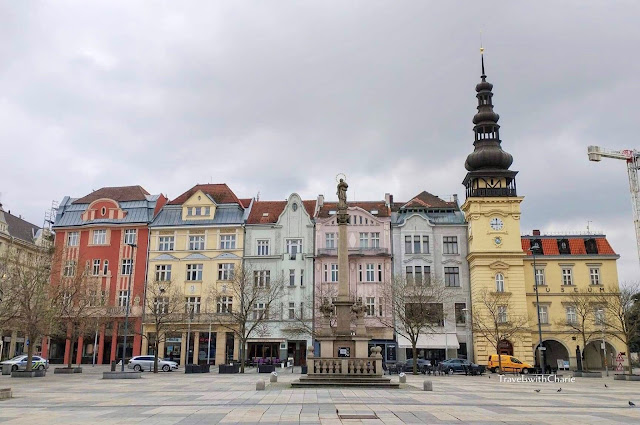Masaryk Square and the Plague Column with the Virgin Mary
Ostrava was founded in 1267 on the banks of the Ostrá (Ostravice) river. The town prospered from mining its rich black coal deposits. That was halted in 1994 due to environmental degradation. Ostrava today is one of the major European hubs in the automobile industry.
Ostrava is the second largest city in Czechia in area and the third largest in terms of population. The city’s logo Ostrava !!! embodies its dynamics. The three question marks allude to its vitality, energy and confidence. The Ostrava blue is taken from traditional armorial emblems.
Church of St. Wenceslas
St. Wenceslas is the oldest monument in Ostrava. The first church was built on this site in the 13th century. The church has been restored a few times over the centuries. Notice the Baroque onion dome which is a later addition.
Cathedral of the Divine Saviour
When the Church of St. Wenceslas could no longer accommodate the increasing number of parishioners in the area, a new church was built. The Divine Saviour has room for 4,000 people. It was dedicated in the 19th century. Gustav Meretta was the chief architect of the Cathedral and the interior is the work of Max von Ferstel.
Interior of Cathedral of the Divine Saviour
Madona by Nils Westergard
Thoughtful work by American street artist, Nils Westergard. There’s a bit of hope in the facial expression of Madona (whose name is Meredith in real life). It covers the wall of an otherwise derelict building which was once a department store.
Nice contrast between the 13th c Church of St. Wenceslas and contemporary street art.
Antonin Dvorak Opera House
Antonin Dvorák was a Czech composer who was the first Bohemian to gain international renown for his music. Most famous among his compositions is the New World Symphony or Symphony no. 9 in E minor, opus 95. You can listen to it here: https://youtu.be/3ZF4n7lshik.
Czech architecture and design
Ostrava-Opava Diocese Office with statue of St. Hedviky Slezka
Sculpture of workers, a Czech 20th century design
Many buildings in the city center sport a fresh coat of paint and streets are well maintained. Ostrava city center is quiet and I wondered where everyone was.
How to get there:
From Vienna: I left from the main train station in Vienna and the trip took approximately 3 hours.
Upon arrival in Ostrava, I took an Uber to my hotel in the center of town. It costs about $5.00.
From Poland: Ostrava is only 19 km. from the Polish border. The closest major city to Ostrava is Katowice. From Krakow to Ostrava is about three hours by train. The train station in Ostrava is small but it can be confusing as some of the tracks have the same number. Always check with the Information desk to confirm which platform you’re departing from. In comparison, the main train station in Krakow is vast and quite busy.
Where to stay:
Imperial Hotel Ostrava, Tyršova 750
This hotel has the best location in town. It is in the historical center so I walked to all the places I’ve written about here. There are many restaurants close by and a grocery store. I also noticed that there are several tram lines near the hotel.
Where to eat:
La Brasserie at Imperial Hotel
I was glad to eat dinner at this restaurant especially since it was raining. The staff members were attentive but not intrusive. I appreciated the comfortable ambiance. And the salmon I ordered came with lots of vegetables. It was a good, filling meal after a long day of travel. Slightly less than €18.00 with bottled water.
*****Images by TravelswithCharie












